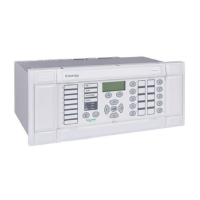Commissioning P54x/EN CM/La4
MiCOM P543, P544, P545 & P546
CM) 10-37
CM
8. SETTING CHECKS
The setting checks ensure that all of the application-specific relay settings (i.e. both the
relay’s function and programmable scheme logic settings), for the particular installation, have
been correctly applied to the relay.
If the application-specific settings are not available, ignore sections 8.1 and 8.2.
Not
e: The trip circuit should remain isolated during these checks to prevent
accidental operation of the associated circuit breaker.
8.1 Apply application-specific settings
There are two method
s of applying the settings to the relay:
Transferring them from a pre-prepared setting file to the relay using a portable PC
running the appropriate software via the relay’s front EIA(RS)232 port, located under the
bottom access cover, or rear communications port (with a KITZ protocol converter
connected). This method is preferred for transferring function settings as it is much
faster and there is less margin for error. If programmable scheme logic other than the
default settings with which the relay is supplied are to be used then this is the only way
of changing the settings.
If a setting file has been created for the particular application and provided on a diskette,
this will further reduce the commissioning time and should always be the case where
application-specific programmable scheme logic is to be applied to the relay.
Enter them manually via the relay’s operator interface. This method is not suitable for
changing the programmable scheme logic.
Note: It is essential that where the installation needs application-specific
Programmable Scheme Logic, that the appropriate .psl file, is
downloaded (sent) to the relay, for each and every setting group that
will be used. If the user fails to download the required .psl file to any
setting group that may be brought into service, then factory default
PSL will still be resident. This may have severe operational and
safety consequences.
Note: If, as a result of applying the application settings, the communication
mode [2010 Comms Mode] has been changed, then a ‘comms
changed’ alarm will be raised on the user interface. This alarm can
only be cleared by power cycling the relay. If the alarm appears,
remove and then re-apply the auxiliary supply to the relay.
8.1.1 Protection communications loopback
If the phase
differential protection is enabled, and/or InterMiCOM
64
is being used for the
signalling channel, the communication loopbacks that were tested earlier need to be
maintained whilst scheme testing is being performed. Cell [0F13 Test Loopback] of the
COMMISSIONING TEST column should be set to ‘External’, the contents of cell [0F15 IM64
TestPattern] should have all bits set to 0 initially, and cell [0F15 IM64 Test Mode] should be
set to ‘Enabled’.
8.1.2 Reset statistics
The protectio
n communications / InterMiCOM
64
communications statistics should be reset at
this point. The [0530 Clear Statistics] cell in the MEASUREMENTS 4 column is used for
this.

